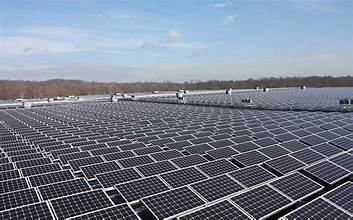Maryland’s push for clean, affordable energy just got a major boost. A large rooftop solar installation on a shopping center is now set to power hundreds of homes through the state’s community solar program. This move is expected to help local families save money on electricity bills and reduce greenhouse gas emissions.
The project, which was announced earlier this month, involves installing a high-capacity solar energy system on the roof of a major shopping center located in Prince George’s County, Maryland. This installation is part of Maryland’s Community Solar Pilot Program, a statewide initiative that allows residents to subscribe to shared solar power sources, even if they cannot install solar panels on their own roofs.
Solar Energy for All—Not Just Homeowners
Many Marylanders live in apartments, condominiums, or shaded properties where rooftop solar isn’t an option. That’s where community solar programs come in. These programs allow subscribers to purchase or lease a portion of the power produced by a larger, shared solar project—such as the one being built on this shopping center.

Once the project is completed, residents can subscribe to the solar energy and receive credits on their monthly electricity bills. This helps reduce their costs while also supporting the growth of renewable energy across the state.
According to the Maryland Energy Administration, community solar allows access to clean power “without upfront costs or the need to own a roof.”
Source: Maryland Energy Administration
Project Partners and Goals
The solar array is being developed by a leading solar company in partnership with the shopping center’s property manager and local government. The project aims to generate more than 1.5 megawatts of clean electricity annually—enough to power roughly 300 homes.
In addition to reducing utility costs, the solar installation is expected to offset nearly 1,200 metric tons of carbon dioxide per year. That’s equivalent to taking over 250 cars off the road or planting nearly 30,000 trees.
A spokesperson for the project said,
“We’re excited to bring solar energy to more Maryland residents, especially those who haven’t had access before. This rooftop installation is a model for how commercial properties can serve the public good.”
Maryland’s Community Solar Program: A Growing Success
The Community Solar Pilot Program was launched in 2017 by the Maryland Public Service Commission (PSC). It aims to test how shared solar can be expanded across the state, especially for low-to-moderate-income (LMI) households.

Since its launch, the program has received praise for its inclusive design. A large portion of available solar capacity is set aside for LMI subscribers. This ensures that everyone—not just wealthy homeowners—can benefit from clean energy.
According to the Maryland PSC, the program has helped thousands of residents reduce their power bills by up to 10% or more, all while promoting job creation and environmental responsibility.
Retail Centers as Solar Powerhouses
Using the rooftops of large commercial buildings for solar installations is becoming more common across the United States. Shopping malls, grocery stores, and warehouse clubs have large, flat rooftops that are perfect for housing solar panels.
By using these existing spaces, developers avoid using extra land, helping to preserve green space while also producing clean power.
The shopping center’s property manager commented,
“Our rooftop is an underused asset. With this solar project, we’re not only supporting clean energy but also helping the community and making better use of our real estate.”
This type of project also demonstrates how private businesses can play a key role in public energy solutions. By leasing their roof space to solar developers, commercial property owners can earn rental income while supporting environmental goals.
How Residents Can Join the Program
Once the rooftop solar system becomes operational—which is expected by early 2026—local residents will be able to sign up as subscribers through a participating community solar provider.
Signing up is easy. Most programs allow consumers to:
- Enroll online without installing any equipment
- Receive a portion of energy credits each month
- Save money through lower electricity rates
To learn more about community solar options in Maryland or to find a provider near you, visit the official Community Solar Portal.
A Win-Win for Environment and Economy
Projects like this create a triple benefit for Maryland:
- Lower energy costs for residents
- New local jobs in solar installation and maintenance
- Cleaner air and reduced carbon emissions
Maryland has already committed to sourcing 50% of its electricity from renewable sources by 2030, and this project supports that mission.
With rooftop solar projects like this gaining momentum, it’s clear that the future of energy in Maryland is not only green—but also community-driven.
Conclusion
The rooftop solar installation on a Maryland shopping center is more than just a clean energy project—it’s a symbol of what’s possible when businesses, governments, and communities work together. By opening the doors to renewable energy for renters and those without rooftop access, Maryland continues to lead the way in equitable, sustainable power solutions.
As more shopping centers join the movement, the power of the sun will become even more accessible to everyone.
Also Read – Sue Bird Takes Charge: New Role in USA Women’s Basketball






